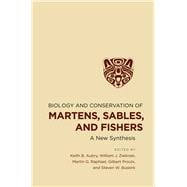
Note: Supplemental materials are not guaranteed with Rental or Used book purchases.
Purchase Benefits
What is included with this book?
| Preface | p. ix |
| Acknowledgments | p. xiii |
| List of Contributing Authors | p. xvii |
| Evolution and Biogeography of the Genus Martes | |
| Synthesis of Martes Evolutionary History | p. 3 |
| Behind the Genes: Diversification of North American Martens (Martes americana and M. caurina) | p. 23 |
| Complex Host-Parasite Systems in Martes: Implications for Conservation Biology of Endemic Faunas | p. 39 |
| Distribution Changes of American Martens and Fishers in Eastern North America, 1699-2001 | p. 58 |
| Biology and Management of Martes Populations | |
| Population Biology and Matrix Demographic Modeling of American Martens and Fishers | p. 77 |
| Evaluating Translocations of Martens, Sables, and Fishers: Testing Model Predictions with Field Data | p. 93 |
| Pathogens and Parasites of Mattes Species: Management and Conservation Implications | p. 138 |
| Ecophysiology of Overwintering in Northern Martes Species | p. 186 |
| Ecology and Management of Habitat for Martes Species | |
| Improved Insights into Use of Habitat by American Martens | p. 209 |
| Habitat Ecology of Fishers in Western North America: A New Synthesis | p. 231 |
| Habitat Ecology of Martes Species in Europe: A Review of the Evidence | p. 255 |
| Advances in Research Techniques for Martes Species | |
| Scale Dependency of American Marten (Martes americana) Habitat Relations | p. 269 |
| The Use of Radiotelemetry in Research on Martes Species: Techniques and Technologies | p. 284 |
| Noninvasive Methods for Surveying Martens, Sables, and Fishers | p. 320 |
| Occupancy Estimation and Modeling in Martes Research and Monitoring | p. 343 |
| Conservation of Martes Populations | |
| Martens and Fishers in a Changing Climate | p. 371 |
| Conservation Genetics of the Genus Martes: Assessing Within-Species Movements, Units to Conserve, and Connectivity across Ecological and Evolutionary Time | p. 398 |
| Use of Habitat and Viability Models in Martes Conservation and Restoration | p. 429 |
| Conservation of Martens, Sables, and Fishers in Multispecies Bioregional Assessments | p. 451 |
| A Century of Change in Research and Management on the Genus Martes | p. 471 |
| Literature Cited | p. 491 |
| Index | p. 577 |
| Table of Contents provided by Ingram. All Rights Reserved. |
The New copy of this book will include any supplemental materials advertised. Please check the title of the book to determine if it should include any access cards, study guides, lab manuals, CDs, etc.
The Used, Rental and eBook copies of this book are not guaranteed to include any supplemental materials. Typically, only the book itself is included. This is true even if the title states it includes any access cards, study guides, lab manuals, CDs, etc.